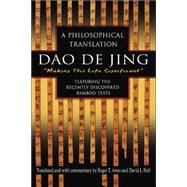
Note: Supplemental materials are not guaranteed with Rental or Used book purchases.
Purchase Benefits
What is included with this book?
| Preface and Acknowledgments | |
| Historical Introduction | p. 1 |
| Historical Context | p. 1 |
| The Nature and Applications of the Daodejing | p. 2 |
| Philosophical Introduction: Correlative Cosmology - An Interpretive Context | p. 11 |
| Optimizing Experience: This Focus and Its Field | p. 11 |
| Daoist Cosmology: An Interpretive Context | p. 13 |
| Getting the Most Out of One's Ingredients | p. 21 |
| Appreciating the Particular | p. 24 |
| The Mutual Entailing of Opposites | p. 27 |
| Aesthetic Harmony | p. 29 |
| Awareness | p. 33 |
| The Wu [actual symbol not reproducible]-Forms | p. 36 |
| The Wu [actual symbol not reproducible]-Forms as "Habit-forming" | p. 48 |
| Glossary of Key Terms | p. 55 |
| Introduction to the Translation | p. 73 |
| Translation and Commentary | p. 77 |
| The Great One Gives Birth to the Waters | p. 225 |
| Thematic Index | p. 233 |
| Bibliography of Works Cited | p. 237 |
| About the Authors | p. 242 |
| Table of Contents provided by Blackwell. All Rights Reserved. |
The New copy of this book will include any supplemental materials advertised. Please check the title of the book to determine if it should include any access cards, study guides, lab manuals, CDs, etc.
The Used, Rental and eBook copies of this book are not guaranteed to include any supplemental materials. Typically, only the book itself is included. This is true even if the title states it includes any access cards, study guides, lab manuals, CDs, etc.
Excerpted from Dao de Jing: A Philosophical Translation by Roger T. Ames, David Hall
All rights reserved by the original copyright owners. Excerpts are provided for display purposes only and may not be reproduced, reprinted or distributed without the written permission of the publisher.